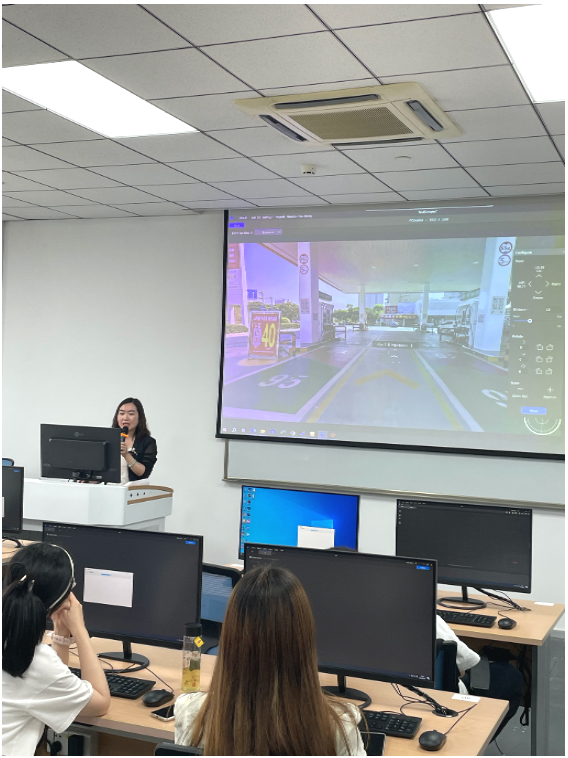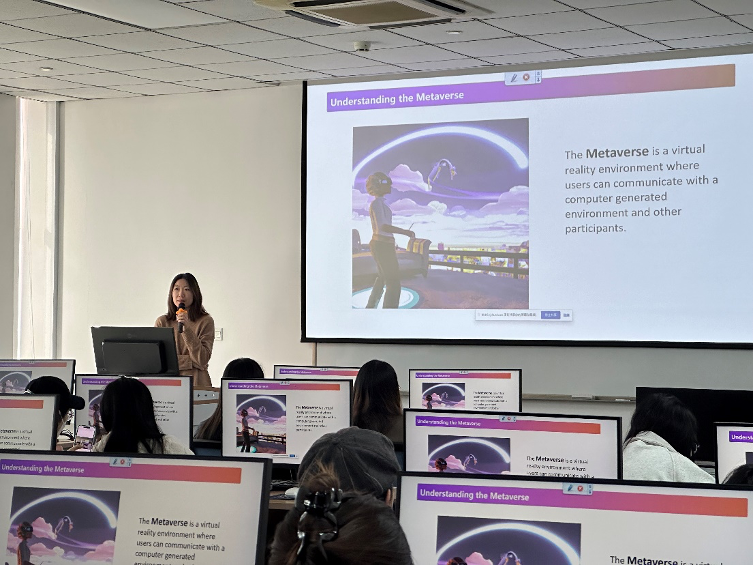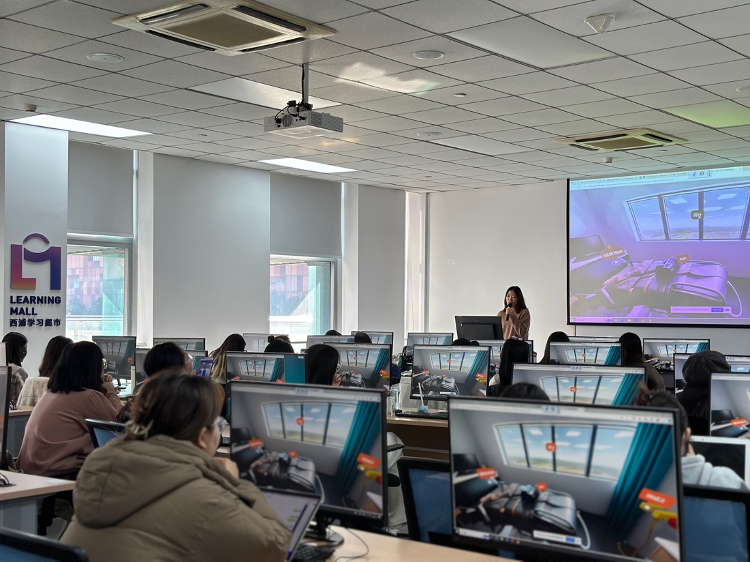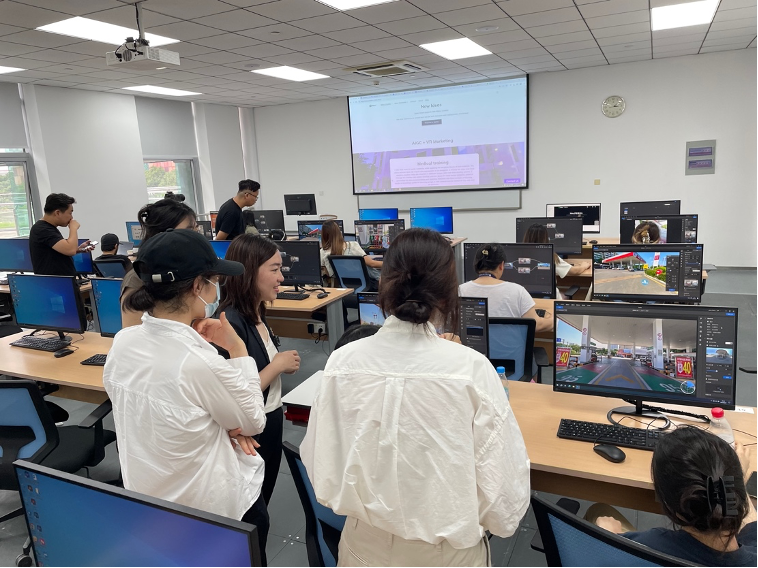(i) Interactive Teaching Interpretation
This paper will explore the application of experiential and interactive teaching, particularly in special education scenarios such as skills training and distance learning. From the perspective of education and teaching methods, we will explore how these novel techniques contribute to the development of new lecture content and modes, as well as examine the integration of virtual reality (VR) and augmented reality (AR) technologies to create immersive three-dimensional teaching scenarios.
Traditionally, classrooms have centered around the teacher, with knowledge being imparted in a unidirectional manner, fostering a passive learning approach often characterized as “indoctrination.” This conventional method tends to result in disengaged students who resort to distractions, such as playing with their phones, to endure uninspiring lectures. Active exploration of intellectual curiosity is lacking, let alone enthusiastic participation. In contrast to the traditional way, interactive teaching environments foster many kinds of interactions, including strong teacher-student and student-student interactions, which motivate students to adopt proactive learning attitudes. Through diverse forms of engagement, students exercise higher-order thinking skills, significantly enhancing their learning efficiency and effectiveness. Interaction is the core of interactive pedagogy, the essence of which is to create a transformative teacher-student relationship, where students evolve into knowledge explorers. Students select, process, handle, assimilate, and internalize the information they collect, combining it with their own experiences, abilities, and backgrounds. During the process, students construct knowledge systems on their own, exercising initiative and creativity in learning.
The specific forms of interaction can be divided into the following categories:
- Question stimulation: The teacher raises key issues, guiding students to think and facilitating the progress of the course.
- Discussion on themes: Starting from a certain teaching theme, the teacher guides students to discuss in depth several issues.
- Case study: Students engage in discussions and problem-solving based on the given case.
- Practice: Conditions are created for students to apply theoretical knowledge and solve real-world problems.
- Scenario simulation: The teacher recreates specific situations from the textbook, allowing students to simulate and apply skills or gain situational experience. These interactions embody three key characteristics: equal roles for teachers and students, emphasis on scenarios and practices, and enhanced integration and cooperation with the real world.
The significance of interactive teaching lies in building a good teacher-student relationship and helping students realize the meaning and value of learning. At the same time, students are motivated to learn, and cultivated with a sense of lifelong learning and innovative learning habits. Ultimately, the shift to interactive learning would elicit reforms and innovations in assessment and evaluation systems, as well as other educational and teaching institutions and mechanisms.
Currently, interactive teaching still has certain limitations, which is palpably evident in large class settings. Managing a substantial number of students poses challenges for teachers, making it challenging to ensure full interaction without technological assistance. Additionally, different subjects demand varied forms of interactivity, requiring tailored designs based on subject characteristics. SMART classrooms become imperative to realize interactive teaching, facilitating the deep integration of educational technology with traditional classroom settings.
(ii) Our Practical Exploration
In response to the limitations of interactive teaching, and to realize the deep integration of technology and the classroom, XJTLU Learning Mall has explored and applied Nibiru Creator, a new content development technology and tool, in the hope of realizing deeper teacher-student interactions and providing personalized classroom design, ultimately enhancing the overall quality of teaching and learning experiences. Nibiru Creator is a code-free interactive content creation and operation tool that allows teachers to quickly grasp its usage without a programming background. It also empowers teaching scenarios with a rich library of templates, intelligent data analysis, and logic programming, which enables teachers to develop 3D interactive content efficiently and cost-effectively.
With the help of Nibiru Creator, teachers can master the skills of creating interactive courseware in a short period, and efficiently complete the construction of interactive virtual teaching content. On one hand, employing virtual simulation breaks through the limitations associated with high costs, difficulty in reproduction, limitations on physical resources, and strict security requirements for the creation of certain teaching scenarios. On the other, every student can fully participate in and immerse themselves in virtual teaching scenarios, and engage in a wide range of learning practices and explorations, thus enhancing their learning concentration and interests, ultimately leading to improved learning outcomes.
To help more teachers understand and master Nibiru Creator, this new type of teaching content development tool, XJTLU Learning Mall has organized a training camp. Teachers can master the skills of building interactive courseware with Nibiru Creator through a period of training, and obtain the teacher certification awarded by Nibiru. To further promote interactive teaching with subject-specific characteristics, XJTLU Learning Mall also held several lectures on meta-universe, imparting metaverse visions and skills to teachers and students majoring in film and TV arts and digital education. Through a combination of knowledge transfer and hands-on practice, the lectures enabled more people to recognize, experience, and master the method of using Nibiru Creator to create interactive courseware. Last but not least, to achieve the effect of technology demonstration, XJTLU Learning Mall engages in peer-to-peer cooperation with teachers to produce interactive courseware. This collaborative approach not only completes the production process but also addresses any challenges encountered by teachers during courseware development, ensuring a comprehensive and supportive implementation of Nibiru Creator in the educational setting.




Through the collaborative projects outlined above, both teachers and students have provided positive feedback. Students and faculty not only acquired the skills to create basic interactive courseware using Nibiru Creator but also exhibited a strong interest in delving deeper into this innovative tool. Following these successful engagements, numerous students enthusiastically enrolled in the Nibiru Creator boot camp program at XJTLU Learning Mall. Actively participating in the creation of interactive courseware, they sought to enhance their learning experience and elevate their teaching skills.
(iii) Showcase of practical programs
- Film and television technology scenic simulation
Description:
XJTLU Learning Mall is actively involved in training and assisting teachers and students specializing in Filmmaking within the School of Film and TV Arts. The focus is on producing 3D interactive teaching scenes. This initiative serves a dual purpose. Firstly, it utilizes virtual simulation technology to conduct pre-studies and preparations, allowing students to engage in insightful discussions with teachers and classmates during class sessions. Additionally, post-class, students can review and practice within the virtual simulation environment, ensuring a profound understanding and mastery of the key points in their professional knowledge. This approach not only enriches the learning experience but also facilitates a comprehensive understanding and application of critical professional concepts.
Access link:
Please use a computer browser to open the above link.
Instructions for use:
Click the Demo button to view the video guide.
Click the Start button to enter the character selection screen. Select different characters to enter the corresponding scene and find the relevant tech scout elements.
- Innovative testing of 3D immersive escape room breakouts
Description:
Through the design of classroom activities, a three-dimensional immersive escape room environment is established. Within this engaging setting, students are tasked with answering questions that serve as assessments of their knowledge mastery. This is an innovation of assessment method that is based on student interest and subject characteristics. Throughout this process, teachers have the opportunity to navigate through the data-gathering points within the activity. They can gather valuable insights into the learning situation, such as learning time and the correction of answers. Armed with this feedback, teachers can make informed adjustments to the curriculum focus and refine teaching methods for subsequent courses.
Access link:
Please use a computer browser to open the above link.
Instructions for use:
View the rules of the chamber and learning objectives, and complete the learning tasks. Each task is the condition for breaking through.
If the answer is correct, the system will jump automatically. Otherwise, you will need to further study and check the answer.
References:
Yuan Mingyue,Li Qingfeng. A Review of Interactive Teaching Methods ResearchA Review of Interactive Teaching Methods[J]. Educational Progress, 2017, 07(06): 415-422. http://dx.doi.org/10.12677/AE.2017.76066





